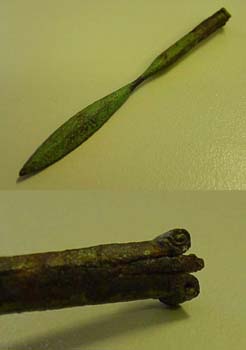Antique medicine |
||
Lancet |
||
Lat. Scalpellum, or scalpellus, in the same meaning the Romans used the word scalprum. Skalpell. "Scalepel is the most famous for all the medical instruments.
The Roman doctors once again defined a standard for the fact that the scientific have differentiate the deficiency. The finds of the scale palp. The following laddies of the spray, which are dated to be daddy. All the findings that were dated, are not older than the early Roman casual period. This could be an indication that this skal phrase is a Roman development. As form and appearance in the Empire time, no longer change, it can be assumed that the scalpel for the Roman doctors was considered mooded. The structure of the scalpel is typical of medical instruments of the Romans, because most instruments were two-sided on the one side The actual scalpel, on the other side a myttie-shaped spatula, which could be used to use the salted pallet spot.
The shape of the blades and the spatula varies very strongly from scalpel to scalpell and can be considered as specialization of the scalpel for certain tasks. The handle of the scalpel usually consists of bronze, on the other hand, iron, which explains why the scalpel usually are found without blade, since the iron blade goes fancy in the soveref as the bronze handle. To secure the blade to the handle, the rectangular shaft was provided with the narrower cut in the baffle ending in a bore. In the bore, the blade could then be fixed. Banked or shame sounded sounds could be replaced without having to dispose of the complete scalpel. Since the scalp handles were partly small artworks, it is only quite understandable that the blades could be replaced. The handles of the scalpel were deemed each year after the purse of the client. Often, the handles were designed with decomposing, in which a metal groove (e.g., gold or silver) was stimulated. It can be assumed that such a skalpel was already expensive to expensive in antiquity. In our current time you will have to be arousing to find a craftsman who usually staff this art. The ornaments were varied and rich by circles and dots over efeuricians up to figurative motives such as birds. In order to look more beautiful, the handles were also partly also provided with cross-casting between spatte and shank "(zit: https://www.antik-heilkunde.de/).
Several Greek and Roman reliefs overlide us the shape of the then common sorgrams, a relief from Roman casual time shows knife with round sounds and spatial handle, two knives with narrow curved blade. The round sounds could be different long and with a different curvature - depending on the purpose of use:" both tip and width knife use, not in all cases to use (to the cupping, use the curved, at the top of not to narrow Knife ("The doctor, Chap.7) More frequently than the corrosion-stage steel blades have the trades are formed, which are usually designed as spatulas. This grip form is so characteristic, which alone to be made of your surgical knife, as well as the sounds are lost, even if the blades are lost, even if the blades are lost, not even when the sounds are lost, the evenly the blades knife are lost: mostly the bronze knife handle (Lat." Manubrium Scalpelli) to a myrtle-shaped, strap splat-spot-spot, with the varices, branch breaks, or tumors after the separation of the overlying skin could be freely spread; without triggering bleeding. Some lateral rummers show inserts made of gold or silver in shaft: Cave, celebrity surgeon at work - that could be expensive! The strong, in cross-section rectangular or round handle had a slot-shaped, in rod-wide extended insert at the upper end, in which the blade was fitted with a groove - she was removed after wear and replaced by a new one. "The staff is at his one end a more or less deep cut, which soon shows in the length of the same width, but soon after the center of the staple can be tightened to scented. At his end but the cut-in spread is reversed in this way, his cross section at this point is circular. In this incision now the fitting to the fixed in the clip certain end of the blade fits in the right. The rolling widened had the purpose of being a sliding or invalidity of the blade from the strip to prevent" (*). This connection of blade and handle proved to be so much that you are in Steinshal as well as in Greece and Italy, Germany and England.
(*) Th. Meyer-Steinge and Sudhoff, history of medicine at a glance with Fig. 1922, p. 17. Location: Trier, on the so-called meat market Length 110 mm |




